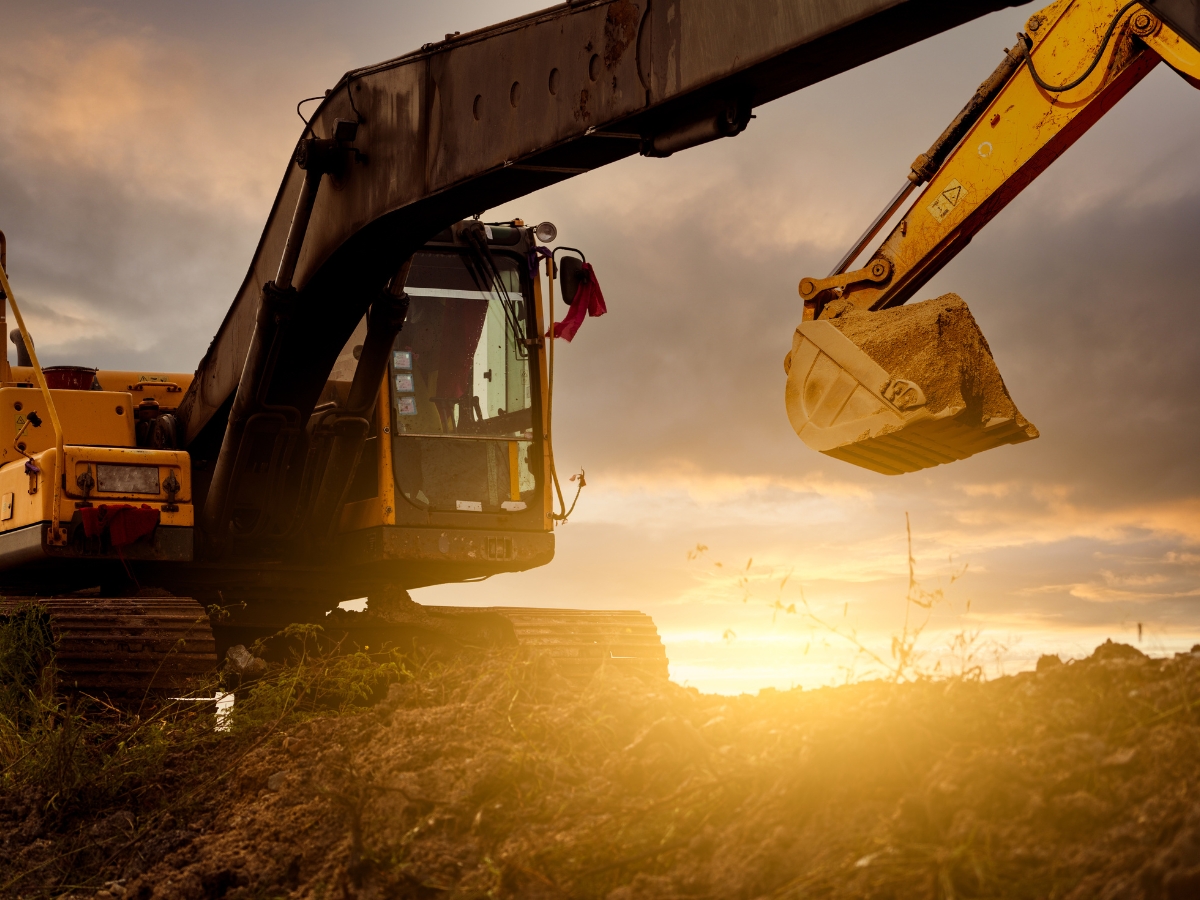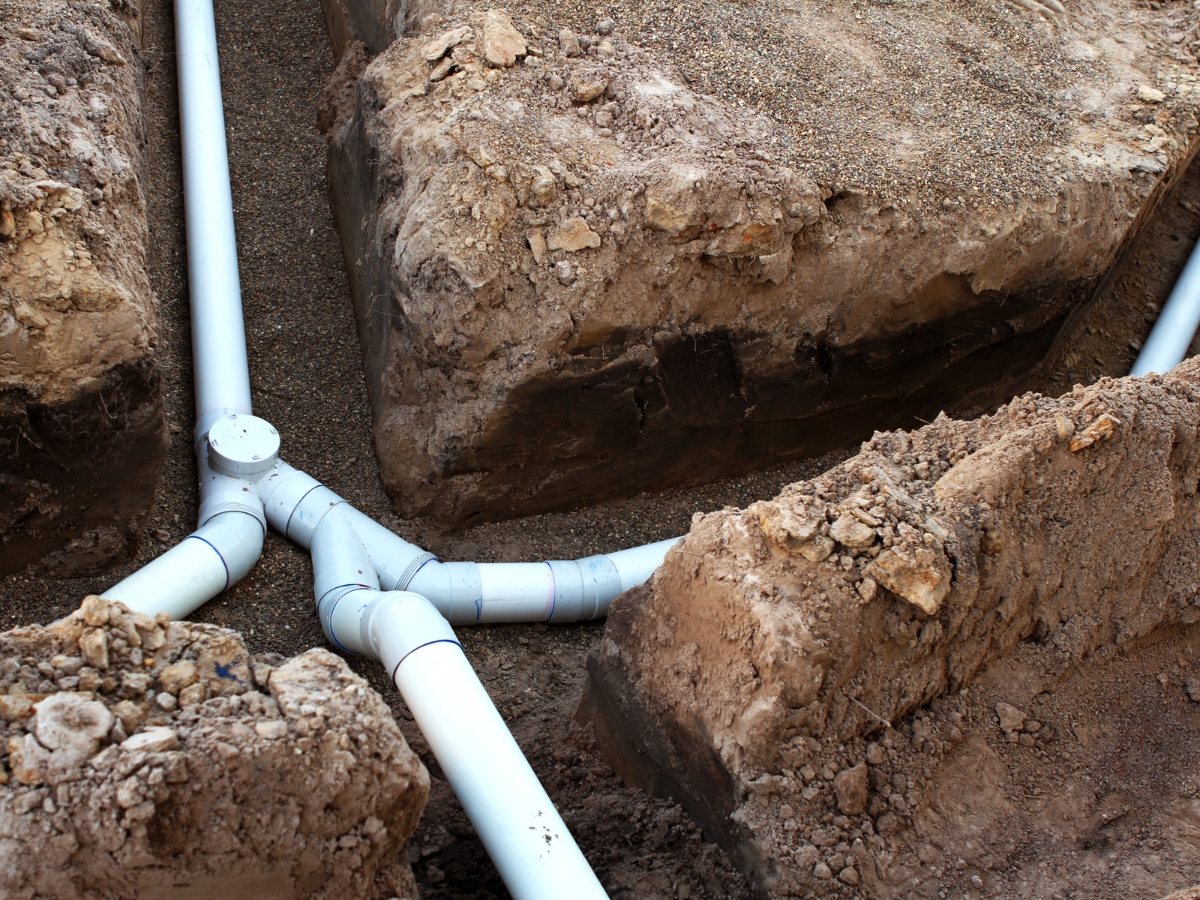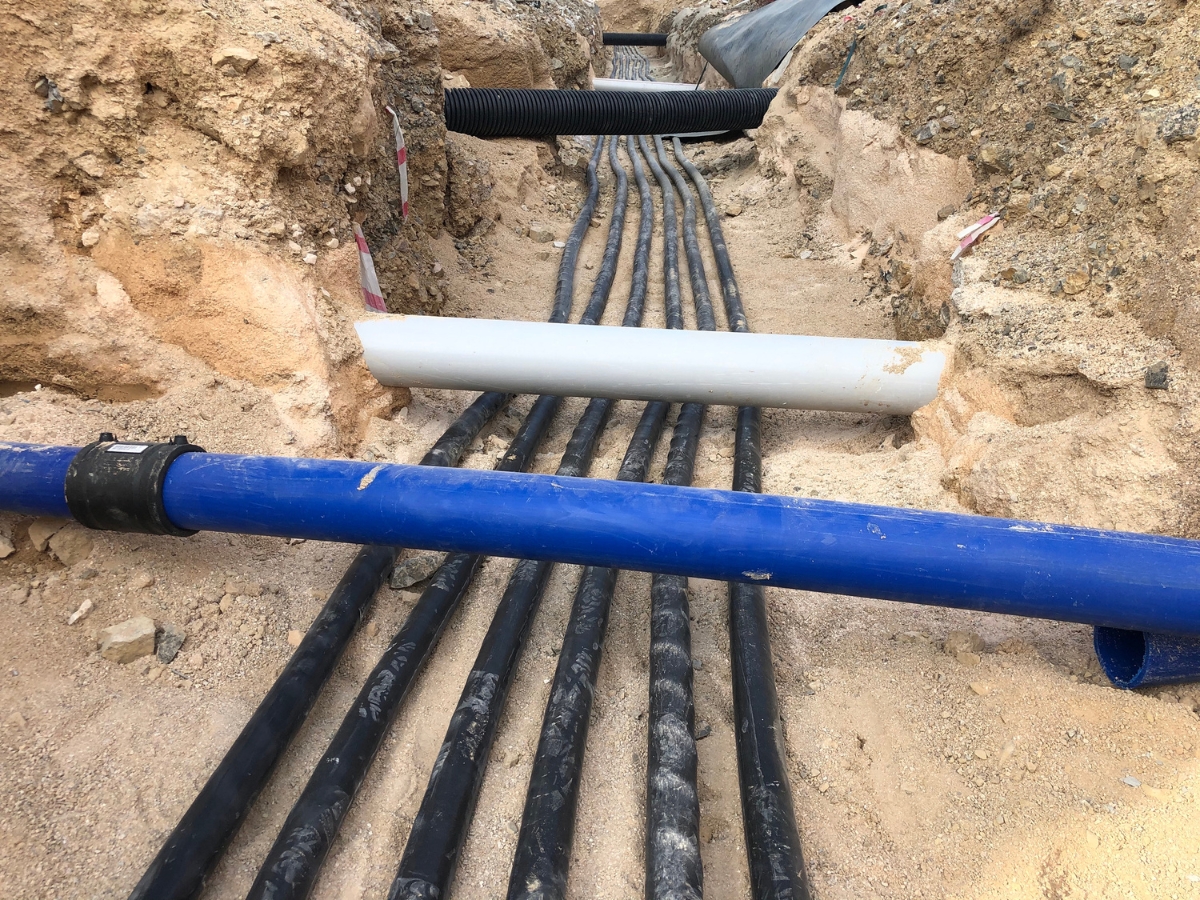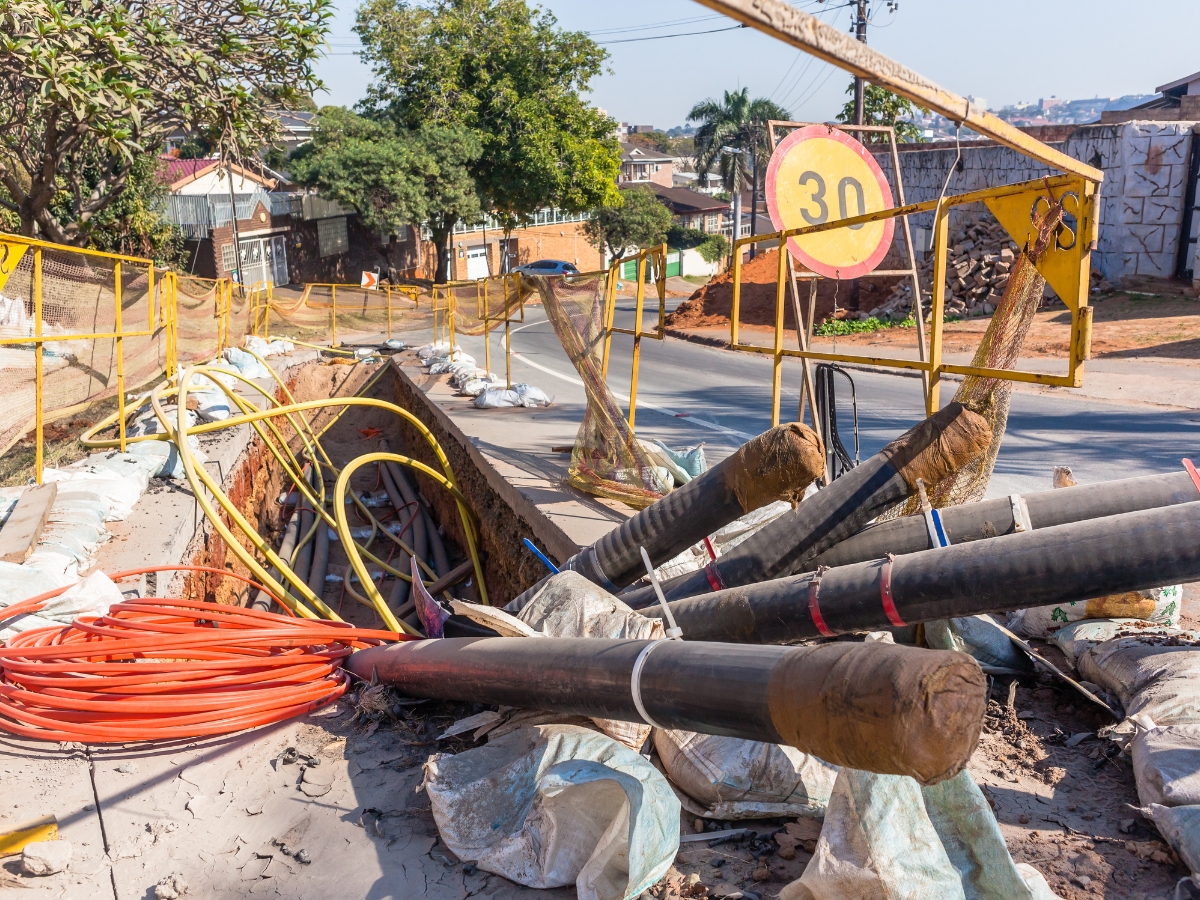Trenching is an essential consideration in any construction project, as it involves the excavation process for laying down utilities such as power lines and water pipes. During the planning phase, one question is whether power and water lines can be laid in the same trench. The answer is yes, but it is essential to follow specific safety guidelines and precautions to avoid potential hazards and comply with local codes.
When space is limited, or there’s a desire to reduce the costs and disruption associated with separate excavations, combining power and water lines in a single trench can be an attractive option. However, this approach also presents unique challenges and risks – particularly if the appropriate steps aren’t taken to ensure workers’ safety and the installed utilities’ integrity. Professional guidance is crucial when undertaking such projects, as the consequences of failing to adhere to the necessary safety protocols can be severe.
Key Takeaways
- Combining power and water lines in a single trench is possible with proper safety measures.
- Adherence to local codes and professional guidance is crucial for the success of shared trenches.
- Considering advantages, disadvantages, and alternatives can help stakeholders determine the feasibility of combined trenches.

Fundamentals of Trenching
Trenches are a type of excavation characterized by being deeper than they are wide and typically narrow in relation to their length. They are commonly used in civil engineering and construction projects for installing underground utilities such as power lines and water pipes.
Power Trenches
Power trenches are excavations made for burying electrical lines, which serve as the infrastructure for delivering electricity from generation stations to homes and businesses. Burying power lines provides a number of benefits, including protection from weather-related damage and reduced visual clutter.
When creating power trenches, it is essential to adhere to local regulations regarding minimum depths and clearances from other utility lines or structures. Underground electrical lines must also meet minimum coverage depths to ensure safety and maintain electrical performance.
The following considerations should be taken into account when digging power trenches:
- Proper markings of the route, ensuring the trench is clear of other utilities and potential hazards
- Appropriate erosion control measures such as silt fences, wattles, or other temporary devices
- Ensuring that the trench meets the required minimum depth for the specific electrical line being installed
- Following proper backfilling procedures, including compacting the soil to avoid future settling of the trench area
- Restoring the excavation area, if necessary, to minimize the impact on the surrounding environment

Water Trenches
Water trenches are excavations designed for the installation of underground water lines, which transport potable water from treatment plants to homes and businesses. Similar to power trenches, water trenches must follow local regulations and meet minimum coverage depths for safety reasons.
Key factors to keep in mind when digging water trenches include:
- Ensuring the trench is free of other utility lines and potential hazards
- Proper erosion control measures to contain sediment and protect nearby water sources
- Installing water lines at the appropriate depth to avoid future damage from frost or other environmental factors
- Using approved materials for water lines, which may vary depending on local building codes or the type of water being transported (e.g., potable water versus wastewater)
- Following correct backfilling procedures to protect the water line and maintain the integrity of the surrounding soil structure
Creating separate trenches for power and water lines can help reduce the need for future maintenance and improve overall efficiency. However, in some cases, power and water lines may share a trench if installed using appropriate methods and local regulations allow, such as maintaining a minimum separation distance between the utilities. It is important to consult with local authorities and utility companies when planning trench installations to ensure compliance with all guidelines and requirements.

Electrical Dangers
When electric and water lines are installed in the same trench, there are inherent risks involved. One of the main concerns is the potential for accidental electric shock. If an electrical cable becomes damaged, it may come into contact with the water line, leading to a hazardous situation for both workers and anyone nearby. To mitigate this risk, proper installation methods and coverage depths are crucial. Ensuring that both electrical line and waterline have adequate separation and insulation can help to prevent accidental shocks.
Furthermore, if an electrical fault occurs while the utilities are sharing a trench, workers trying to access the waterline for repairs may face an increased risk if the electrical cables are live. Consequently, it is important to take necessary precautions and follow safety guidelines provided by organizations like OSHA to ensure the wellbeing of those working in or around shared trenches.
Water Contamination
Aside from electrical dangers, there is also the risk of water contamination when electric and water lines share a trench. If a waterline becomes compromised, contaminants may seep into the water supply, potentially affecting the health and safety of those who consume it. This issue can be exacerbated if electrical cables are improperly installed, allowing chemicals from the cable insulation to leach into the water supply.
To safeguard against water contamination, professionals recommend appropriate separation between the electric and water lines, as well as the use of durable, non-toxic materials for insulation. Adhering to strict safety guidelines, such as those outlined by OSHA, can also help to minimize the risk of contamination.
In conclusion, while it is possible to have electrical and water lines share the same trench, it is crucial to follow proper installation procedures and safety guidelines. This will help to reduce risks associated with electrical dangers and water contamination, ensuring the safety of workers and those who rely on these utilities.

Advantages and Disadvantages
Shared trenches, where electrical and water lines are installed together, can offer several benefits. For example, these trenches can save space and reduce the amount of excavation required. This can lead to a reduction in overall project costs when compared to installing separate trenches. In some cases, there might be no alternative but to use shared trenches due to limitations in space.
Another advantage of shared trenches is that they can allow for more efficient maintenance and repairs. When both utilities are located closer together, it may be more convenient to perform inspections, identify potential issues, and make necessary repairs. This can help to minimize disruptions and ensure a more seamless service for customers.
Additionally, shared trenches may contribute to a more aesthetically pleasing environment. By reducing the number of trenches and their impact on the landscape, shared trenches can help maintain a visually appealing environment for residents and passersby.
Despite their potential benefits, shared trenches can also have some disadvantages. One of the main concerns with sharing trenches is the potential for interference between the two utilities. The close proximity of electrical and water lines could lead to issues such as electromagnetic interference (EMI) or the risk of the two utilities coming into contact with one another.
EMI occurs when electrical currents create magnetic fields that can interfere with other nearby conductors, potentially causing disruptions to power or water service. In order to mitigate this risk, regulations and codes often require a minimum separation distance between electrical and water lines within a shared trench, which can vary depending on local requirements.
Even with the proper separation, there’s still a risk of the two utilities coming into contact in the event of an accident or natural disaster. Ensuring that the electrical and water lines are adequately insulated and protected can help to minimize this risk, but it can also increase the project’s cost and complexity.
Another drawback of shared trenches is that they can limit future development and expansion possibilities. When electrical and water lines are installed in the same trench, it can be more challenging to make adjustments to one utility without affecting the other. This can result in reduced flexibility and an increase in the cost and complexity of future upgrades or expansions.
Determining Feasibility
When considering whether to run power and water lines in the same trench, there are several factors to evaluate. This section will discuss local regulations and technical factors that can impact the feasibility of such a project.
Local Regulations
Local regulations play a crucial role in determining whether running power and water lines in the same trench is permissible. Different cities and municipalities may have their own rules and guidelines governing trenching for utilities. It is essential to consult with your local building department or utility providers, who can provide up-to-date information on any restrictions or requirements in your specific area.
For example, some local codes may require specific separation distances between utilities, while others may allow shared trenches under certain conditions. One example of a guideline that may be in place is the requirement that electrical lines be buried deeper than water lines in case a plumber hits an electric line while digging for a water line, as seen in a Mike Holt’s Forum discussion.
In addition to local regulations, it is worth noting that national or international standards may apply, governing how utilities are installed and trenches are dug. These standards aim to ensure the safety and reliability of utility networks. It is always a good practice to adhere to these specifications, as deviating from them may result in suboptimal or even hazardous installations.
Technical Factors
Aside from local regulations, there are several technical factors to consider when determining the feasibility of running power and water lines in the same trench. These factors may impact the safety, efficiency, and longevity of the utilities in question.
- Separation Distances: It is crucial to maintain adequate separation between power and water lines when sharing a trench. This can help prevent cross-contamination, electrical interference, and other potential hazards. For instance, one guideline suggests installing power lines at least 4 feet below grade, with trenching 8-12 inches deeper than water pipes , depending on soil type and trench location.
- Utility Proximity: When designing an underground utility system, it is essential to account for the location and proximity of other existing utilities. Crowded or congested utility corridors may limit the feasibility of installing power and water lines in the same trench.
- Soil Conditions: Soil type and conditions can have a significant impact on trenching, as certain soils may be more challenging to excavate or require specific backfilling techniques. Additionally, soil composition may affect drainage and the behavior of the utilities themselves, sometimes necessitating additional precautions when laying utilities in the same trench.
- Installation Method: The method used to install utilities can also affect feasibility. Some methods, such as horizontal directional drilling, may allow for greater flexibility in accommodating multiple utilities within a single trench, while traditional open-cut methods may have stricter constraints on separation distances and other factors.
Overall, when determining the feasibility of running power and water lines in the same trench, it is essential to thoroughly evaluate local regulations and technical factors. Ensuring that both the legal and practical aspects of trench-sharing are met can help create a safe, efficient, and reliable utility network.
Alternative Approaches
Separate Trenches
One common approach to avoid potential hazards and complications when installing power and water lines is to use separate trenches. By allocating independent trenches for each utility, the risk of interference between the two systems is greatly reduced.
Moreover, this method ensures that utility repair and maintenance can be conducted independently without affecting the other system’s functionality. Each trench will also have sufficient space for future accommodations or modifications to the utilities.
While separate trenches may require more time and resources, it provides a confident, knowledgeable, and clear means to prevent complications.
Advanced Technology Solutions
In recent years, advanced technology solutions have emerged that help minimize the risk of running power and water lines in close proximity. Such solutions often involve the use of high-quality, durable materials and innovative designs that prevent the mixing or interference of power and water within a shared trench.
One example of an advanced solution is the use of specialized conduit systems. These systems are designed to protect both power and water lines from external damage, and can effectively isolate the utility lines from one another.
Additionally, the implementation of smart sensors and monitoring systems can also assist in ensuring the utmost safety. By constantly analyzing and monitoring the utilities’ performance, these systems can detect potential issues and provide real-time notifications, allowing for prompt and efficient resolution.
Despite the benefits of utilizing advanced technology solutions, it is crucial to carefully consider the cost, feasibility, and long-term reliability of such systems. While they may be effective in minimizing risks associated with running power and water lines in the same trench, their suitable implementation must be customized to each unique project.
In summary, whether choosing separate trenches or advanced technology solutions to install power and water lines, it is essential to evaluate the project’s specific needs, available resources, and potential risks. Through careful planning, thorough research, and professional consultation, the most appropriate approach can be selected and safely implemented.




